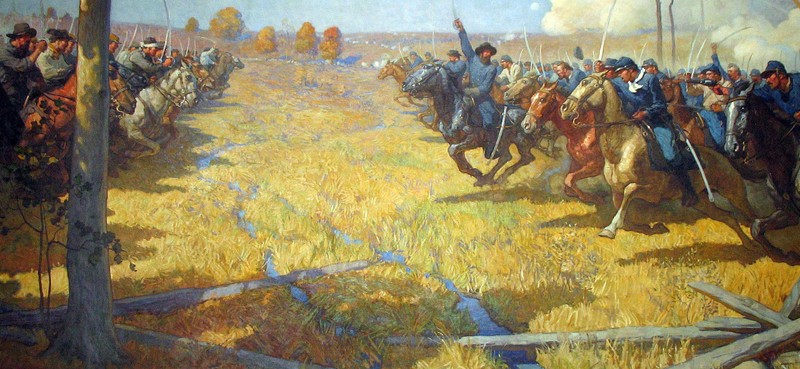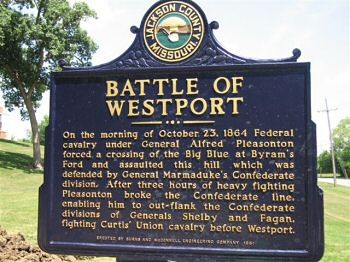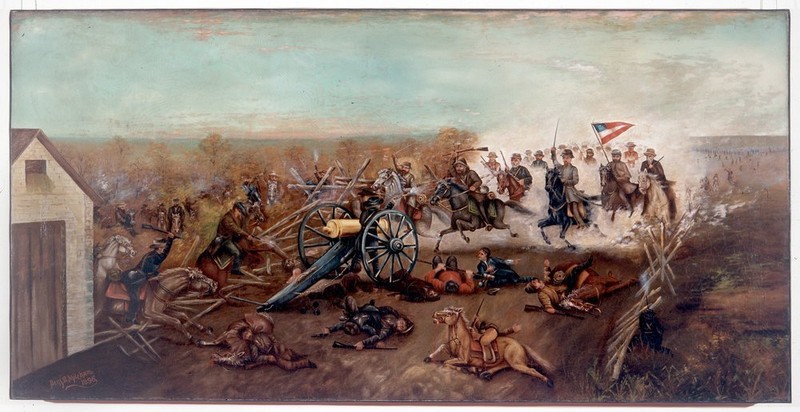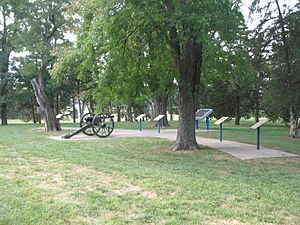Battle of Westport Historical Marker Tour Stop 18 (Battle of Westport Driving Tour) (Price's Raid)
Introduction
Text-to-speech Audio
Dedicated in 1961, this historical marker commemorates the pivotal moment in the Battle of Westport when General Pleasonton's forces made a successful assault on Confederate forces who had occupied this hill on the morning of October 23, 1864. After three hours of heavy fighting, Union forces broke through Confederate lines. The Battle of Westport is widely regarded as the most critical battle of the Civil War that occurred west of the Mississippi River. The battle occurred in modern-day Kansas City from October 21-23, 1864, and the Confederate defeat was a turning point in the war in this region and marked the end of the Confederate threat in the West. As the largest battle in the West, with over 30,000 combatants, the three-day battle resulted in about 1,500 deaths on each side. The scale, significance, and high casualties led to the Battle of Westport being known as the “Gettysburg of the West” among some historians.
Images
The climax of the Battle of Westport at Brush Creek in a fanciful painting by N.C. Wyeth at the Missouri State Capital. Though cavalry charges did take place, much of the fighting was dismounted. Some units lacked sabers altogether.

Battle of Westport Historical Marker. Dozens of markers throughout Big Blue Battlefield Park, Kansas City, and Independence chart the progression of events surrounding the Battle of Westport.

A painting of Capt. Ross Burns's Union artillery in action at Mockbee's Farm on Oct. 22, 1864. Burns may have had the painting done by Benjamin Mileham to commemorate his cannon's contribution to the fight, though they were eventually overrun.

Cannon at Loose Park. Replica artillery also serve as markers for important locations in the Battle of Westport.

Backstory and Context
Text-to-speech Audio
The fighting was not centered around a singular battlefield like Antietam, Gettysburg, and other pivotal battles of the Civil War. Instead, the three days of constant fighting occurred in a series of large battles and smaller skirmishes scattered around Kansas City, including the Little Blue River, Big Blue River, Independence, Byram's Ford, Mockbee's Farm, Shawnee Mission, and Brush Creek. Visitors to the Battle of Westport Visitor Center and Museum can experience the entire history of the battle. The 32-mile self-guided tour of the Battle of Westport traces the routes of the armies over adjacent battlefields along the Big Blue River in the Byram's Ford Historic District. Several replica artillery items are placed along the self-guided tour. The battlefield has been listed on the National Register of Historic Places since 1989, and this battlefield has been preserved through the tireless efforts of the nonprofit Monnett Battle of Westport Fund. One of the central sites of the three-day battle is now Kansas City's Loose Park.
The origins of the Battle of Westport are mired in political intrigue and controversy, but its beginning can be traced to the Confederacy’s desire to install secessionist Thomas Reynolds as the Missouri State Governor in Jefferson City and to establish a “legitimate” Confederate state government (despite a heavy concentration of Southern sympathizers in the state, Missouri never actually seceded). Furthermore, by capturing the state for the South, Price and the Confederacy hoped that the loss would negatively affect Lincoln’s chances for re-election in November, 1864.
Thus, in September of 1864, Price led 12,000 soldiers, mostly cavalry and militia, on a legendary raid into the heart of Missouri. Although they initially targeted St. Louis, Price soon realized that his rather small army would not be able to penetrate the city’s considerable fortifications.
After turning back from St. Louis, Price and his Army of Missouri headed towards Jefferson City. Light skirmishes ensued, and Price and his army also turned away from Jefferson City. Disease, desertion, and death brought the Army of Missouri’s numbers down, but he received a steady supply of recruits from pro-Confederate counties as he passed through.
Ahead and behind Price, the Union response was building. General Samuel R. Curtis patched together 15,000 volunteers and militia from Kansas and Missouri into a well-supplied “Army of the Border,” which he stationed along the Big Blue River between Independence and Kansas City, intending to block Price’s movement west. Back in St. Louis, Rosecrans sent General Alfred R. Pleasonton to tail Price with 10,000 cavalry, hoping to trap the Confederates between the two armies.
After pushing back Union delaying forces at Lexington, the Little Blue River, and Independence, Price finally squared off across the banks of the Big Blue on the morning of October 22, 1864. But Price appreciated the strength of Curtis’s defenses and, leaving a diversionary force behind, slipped southward with his army. By the time Curtis realized Price wasn’t going to attack via the Kansas City Road, the Confederates were more than 10 miles south, crumpling his weak right flank at Byram’s Ford.
Price pushed his way across the Big Blue River while Curtis scrambled to realign his defenses to meet this new threat. Luckily for Curtis, Pleasonton was now on the scene, attacking the Confederate rearguard in Independence. Despite having beaten back Union forces from the ford and at Mockbee’s Farm, Price was still in danger of being caught in the vise between the two Union armies.
On October 23, that is precisely the fate that befell Price’s beleaguered army. Though Curtis’s men suffered some early reversals along Brush Creek, just south of Westport, their lines held and began to drive the Confederates back while Pleasonton hammered the Confederate rearguard and pushed across Byram’s Ford, just as the Rebels had done the day before. By afternoon, the situation was hopeless. The Confederate lines collapsed and a general rout commenced southward. Union cavalry would pursue Price’s army for several days afterward, annihilating more than half the force and ending organized Confederate resistance in the Trans-Mississippi Theater.
Battle of Westport Visitor Center and Museum
The Battle of Westport Visitor Center and Museum is located in the heart of Kansas City's Westport neighborhood at 4000 Baltimore. The museum's largely volunteer-based staff lead efforts to preserve the battlefield while introducing visitors to this monumental moment in the Civil War. Opening in 2008, the Visitor Center and Museum depict the experiences of both civilians and soldiers who were caught in the horrendous fighting of this battle, and galleries and exhibits showcase several nuances of the battle, ranging from the Price raid to the lives and culture surrounding Westport citizens.
There are two self-guided tours for visitors to further immerse themselves in this battle's history, including the 32-mile Battle of Westport Auto Tour and the Big Blue Battlefield Walking Tour. The automobile tour starts at the Westport District of Kansas City and stops at 25 major sites associated with the battle. The Big Blue Battlefield Walking Tour follows the historic route of Byram’s Ford Road over the battlefield. At the top of Bloody Hill, a cannon marks the spot of Pratt’s Artillery Ford as it stood on October 23rd, 1864.8
Marker Inscription: On The morning of October 23, 1864 Federal cavalry under General Alfred Pleasonton forced a crossing of the Big Blue at Byram’s Ford and assaulted this hill which was defended by General Marmaduke’s Confederate division. After three hours of heavy fighting Pleasonton broke the Confederate line, enabling him to out-flank the Confederate divisions of General Shelby and Fagan fighting Cutis’ Union cavalry before Westport.
Cite This Entry
Newcomer, Daniel et. al. "Battle of Westport Historical Marker Tour Stop 18 (Battle of Westport Driving Tour) (Price's Raid)." Clio: Your Guide to History. March 15, 2025. Accessed April 1, 2025. https://theclio.com/tour/333/10
Sources
1. Sinisi, Kyle S.. The Last Hurrah: Sterling Price's Missouri Expedition of 1864. Rowman & Littlefield, 2015. pp.217-247. Sinisi points out that there is little documented evidence to support the anecdotal versions of "Bloody Hill," noting that neither side reports more than 100 casualties in several hours of fighting.
2. Swain, Craig. Pleasonton, Price, and the Big Blue River. To the Sound of the Guns. October 22, 2014. Accessed December 11, 2017. https://markerhunter.wordpress.com/2014/10/22/pleasonton-big-blue/
3. Webb, W.L.. The Centennial History of Independence, MO. Independence, MO. Self, 1927. http://vintagekansascity.com/historyofindependence/chapter_13_second_battle_of_indep.html
4. Collins, Charles Jr. D.. Battlefield Atlas of Price’s Missouri Expedition of 1864. Fort Leavenworth, Kansas. Combat Studies Institute Press, 2016.
5. Sallee, Scott E.. "Missouri! One Last Time: Sterling Price's 1864 Missouri Expedition." Blue & Gray Magazine. Blue & Gray Magazine, 10-20, 48-62.
6. Dick, Titterington. Tour: The Battle of Byram's Ford. The Civil War Muse. Accessed December 12, 2017. http://www.thecivilwarmuse.com/index.php?page=byram-s-ford-battlefield.
7. Beckenbaugh, Terry. "Battle of Westport" Civil War on the Western Border: The Missouri-Kansas Conflict, 1854-1865. The Kansas City Public Library. Accessed Dec, 14, 2017 at http://www.civilwaronthewesternborder.org/encyclopedia/battle-westport
8. Tours. Battle of Westport. Accessed December 14, 2017. http://www.battleofwestport.org/Tours.htm.

